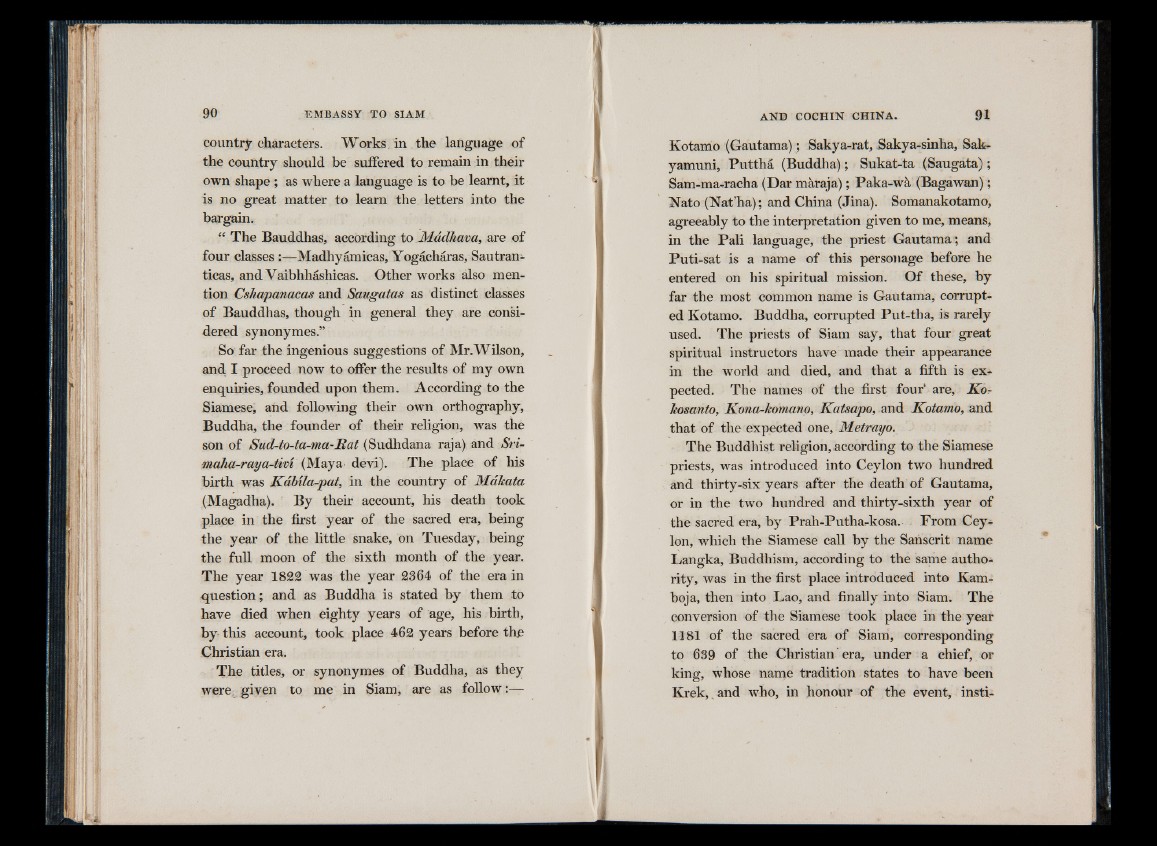
country characters. Works in the language of
the country should be suffered to remain in their
own shape; as where a language is to be learnt, it
is no great matter to learn the letters into the
bargain.
“ The Bauddhas, according to Madkava, are of
four classes :—Madhyamicas, Yogacharas, Sautran-
ticas, and Vaibhhashicas. Other works also mention
Cshapanacas and Saugatas as distinct classes
of Bauddhas, though in general they are considered
synonymes.”
So far the ingenious suggestions of Mr.Wilson,
and. I proceed now to offer the results of my own
enquiries, founded upon them. According to the
Siamese, and following their own orthography,
Buddha, the founder of their religion, was the
son of Sud-to-ta-ma-Rat (Sudhdana raja) and Sri-
maha-raya-tim (Maya- devi). The place of his
birth was Kabila-pat, in the country of Makata
(Magadha). By their account, his death took
place in the first year of the sacred era, being
the year of the little snake, on Tuesday, being
the full moon of the sixth month of the year.
The year 1822 was the year 2364 of the era in
question; and as Buddha is stated by them to
have died when eighty years of age, his birth,
by this account, took place 462 years before the
Christian era.
The titles, or synonymes of Buddha, as they
were, given to me in Siam, are as follow:—
Kotamo (Gautama); Sakya-rat, Sakya-sinha, Sak-
yamuni, Puttha (Buddha); Sukat-ta (Saugata);
Sam-ma-racha (Dar maraja); Paka-wk (Bagawan);
Nato (Nat’ha); and China (Jina). Somanakotamo,
agreeably to the interpretation given to me, means,
in the Pali language, the priest Gautama ; and
Puti-sat is a name of this personage before he
entered on his spiritual mission. Of these, by
far the most common name is Gautama, corrupted
Kotamo. Buddha, corrupted Put-tha, is rarely
used. The priests of Siam say, that four great
spiritual instructors have made their appearance
in the world and died, and that a fifth is expected.
The names of the first four’ are, Ko-
Teosanto, Kona-komano, Katsapo, and Kotamo, and
that of the expected one, Metrayo.
The Buddhist religion,according to the Siamese
priests, was introduced into Ceylon two hundred
and thirty-six years after the death of Gautama,
or in the two hundred and thirty-sixth year of
the sacred era, by Prah-Putha-kosa. From Ceylon,
which the Siamese call by the Sanscrit name
Langka, Buddhism, according to the same authority,
was in the first place introduced into Kam-
boja, then into Lao, and finally into Siam. The
conversion of the Siamese took place in the year
1181 of the sacred era of Siam, corresponding
to 639 of the Christian' era, under a chief, or
king, whose name tradition states to have been
Krek,.and who, in honour of the event, insti